Подмяната на вратите в дома е сериозно начинание, което изисква балансиран подход. Особено внимание трябва да се обърне на мокрите помещения. Не всички материали могат да се използват там. Избор на врати за банята и тоалетната - това далеч не е лесно, тъй като трябва да се вземат предвид много нюанси.
Съдържание на статията
Изисквания
Вратите за банята и тоалетната се избират не само по външен вид. Необходимо е да се вземат предвид и техните свойства. В баните нерядко има висока влажност, така че влагоустойчивостта е важна характеристика. Също толкова важна е и добрата поносимост към мокро почистване. Това е друг критерий за избор. Дълготрайността и надеждността също са важни. Свойства като звукоизолация и ниска топлопроводимост също са важни. В банята се чувстваме комфортно при по-висока температура и е по-лесно да я създадем с врата, която има добра топлоизолационна способност.
Съществуват и технически нюанси. Според строителните стандарти вратите към бани и тоалетни могат да бъдат по-тесни, отколкото към жилищни помещения. Такава е ситуацията в жилищните сгради. В частните къщи и вили това правило не се спазва често, а при ремонт или преустройство на апартаменти често се правят и врати с нормален размер.
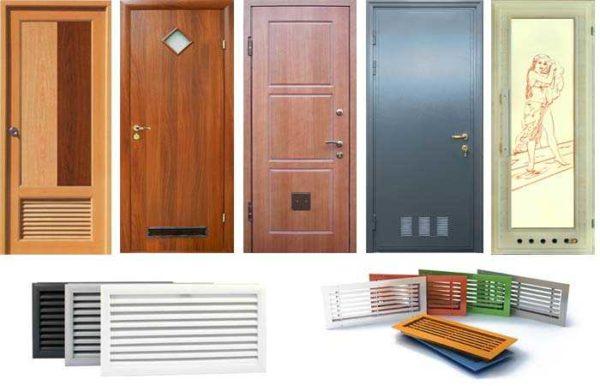
Има и друг нюанс. За бързото отстраняване на влажния въздух е необходима добре функционираща вентилация. Тя може да бъде естествена или принудителна (с вентилатор), но за да работи добре в банята, трябва да има приток на свеж въздух. За да се отвори достъпът на въздух, крилото на вратата се прави с 1,5-2 см по-късо, като се оставя пролука в областта на пода. Това само звучи плашещо и на практика тази междина е почти незабележима. Вторият начин за осигуряване на приток на въздух - специални вентилационни решетки, които се вграждат в крилото на вратата. И третият - въздушни отвори в стената. От всички варианти най-малко се набива на очи идеята с пролука в близост до пода. В същото време тя е и най-лесна за изпълнение.
Какви врати за баня и тоалетна са налични
В банята и тоалетната се поставят дори най-обикновени врати - дървени или филирани (дървена рамка с вложки от шперплат), боядисани с боя. При добре функционираща вентилация те служат добре, но малко хора ги харесват. Затова предпочитат да ги заменят с нови, по-модерни.
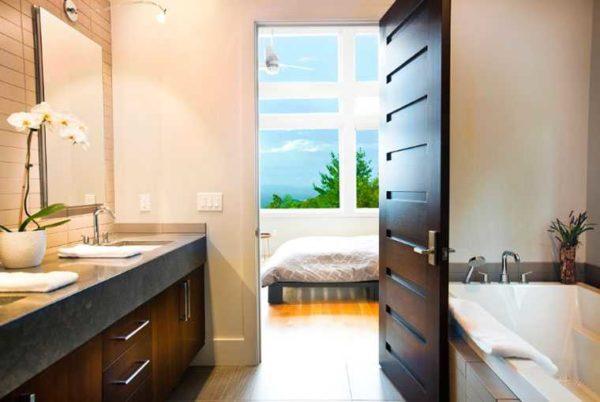
Дървени и фурнировани
Вратите от масивна дървесина са несъмнено красиви, но и скъпи. Те се поставят във влажни помещения, ако са покрити със слой лак. В този случай производителите обикновено посочват в описанието, че те са "водоустойчиви". Ако се използва добър лак и се нанася правилно, покритието предпазва от влага и не се почиства лошо. Ако е необходимо, лаковият слой може да се поднови, въпреки че тази операция няма да е необходима за дълго време.
Фурнированите врати се изработват от евтина нискокачествена дървесина и след това се залепват с фурнир от скъпи видове. Фурнирът е тънък дървен материал с дебелина няколко милиметра. Наличието на лепило прави фурнированите врати не съвсем "естествени", но в същото време предпазва дървото от подуване. Въпреки това фурнированите врати за бани и тоалетни не са най-добрият избор, тъй като фурнирът не е херметичен, влагата прониква и в най-малките пукнатини, което води до изкривяване на повърхността и фурнирът започва да се лющи.
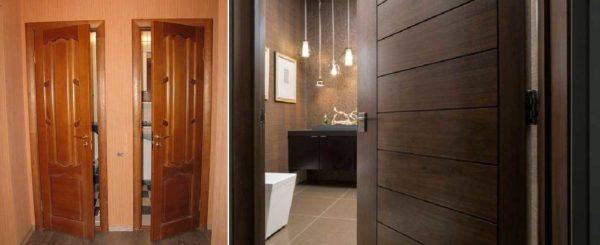
Неотдавна имаше врати с еврофурнир. Това е нов материал, състоящ се от дърво и свързващо вещество. Дървесни влакна, боядисани в различни цветове, се смесват със синтетично свързващо вещество. Тази смес се пресова чрез мощна преса и се получава под формата на лента. На външен вид полученият материал е почти неразличим от естествения фурнир, а експлоатационните му свойства са по-добри. Вратите, завършени с еврофурнир, не се страхуват от висока влажност, покритието има висока механична якост и не избледнява на слънце. Можете да ги различите при допир - твърде гладкото покритие.
Ако говорим за други характеристики, може да се отбележи, че дървените и фурнированите врати за бани и тоалетни имат ниска топлопроводимост и не предпазват добре от шум. Мокрото почистване те понасят, но с мека кърпа и без агресивни почистващи препарати.
Пластмаса и метал-пластмаса
Врати от пластмаса в банята - икономичен вариант. Те струват евтино, не се страхуват от вода в нито едно от състоянията ѝ, не се деформират от висока влажност. Недостатъците им - изработени са от неестествени суровини, евтините модели имат ниска механична якост. Струва си също така да се помни, че те не могат, както вратите от дърво или фурнир, да се "нагласят" до желания размер.
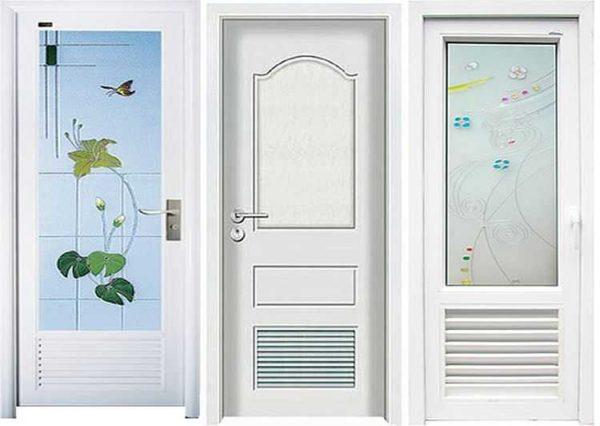
Метално-пластмасовите врати в банята на апартамента се поставят рядко. Но не защото не отговарят на качествата им. По-скоро те не се използват по естетически причини - външният им вид е много различен. Ако в други помещения има врати от други материали, не е лесно да се намери повече или по-малко подходящо оцветяване. Друг възпиращ фактор - значителната цена. А характеристиките - не можете да се сетите за нещо по-добро.
Стъкло
Стъклото не е много популярно като врата, но има добри характеристики. То не реагира на вода и висока влажност, не гние и можете да го миете, колкото искате. Те имат един недостатък - крехкостта, но съвременните технологии са го преодолели - стъклото се прави закалено, което му придава по-голяма здравина. Съществува и ламинирано стъкло (дуплекс и триплекс). Това е, когато листовете стъкло са залепени с подсилващо фолио.
Възможно е да се счупи стъклено крило на врата, но това е трудно, а ако се случи, стъклото се разпада на множество малки парчета с гладки, а не остри ръбове. При ламинираното стъкло парчетата висят върху фолиото, а закаленото стъкло просто се разпада на малки фрагменти, но трябва да се постараете да не се нараните с такива парчета. Единствената неприятност от подобно събитие е необходимостта да се купи нова врата.
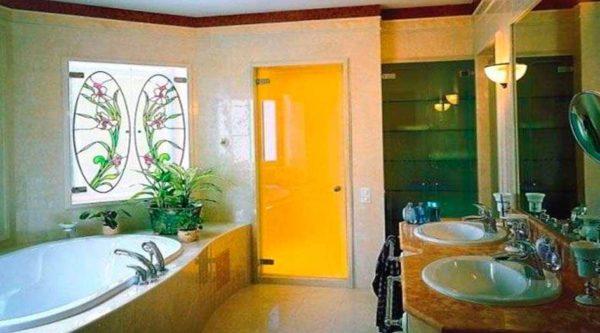
Стъклените врати на баните и тоалетните са непрозрачни. Те се оцветяват, като могат да бъдат с огледален спрей или витраж. Всичко, което може да се види през такива врати, е размазан силует и никаква конкретика. Като цяло не е лош вариант, ако в семейството няма малки деца.
Ламинирани и PVC
Друг евтин вариант за вратите на банята - ламинирано фолио. Самото крило на вратата е изработено по технология на рамката. Рамката се изработва от борова дървесина, пролуките се запълват със звукоизолиращ материал (най-евтиният - велпапе, по-скъпият - полиуретанова пяна), след това - ламинирано фибростъкло или МДФ. Повърхността на вратата може да бъде декорирана под дърво, може да бъде гладка (това е много по-рядко).
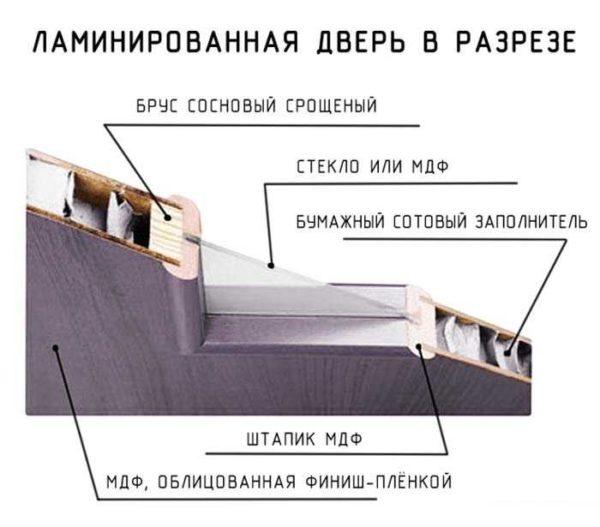
Крилото на вратата е леко, но много лошо понася ударни натоварвания. Ако качеството на ламиниране е добро, такава врата за баня и тоалетна не се страхува от влага и може да се почиства доста добре (с влажна мека кърпа с течни неагресивни почистващи препарати). Докато ламинирането остава непокътнато, тя има доста приличен външен вид. При интензивна употреба филмът се изтрива и външният вид се влошава забележимо.
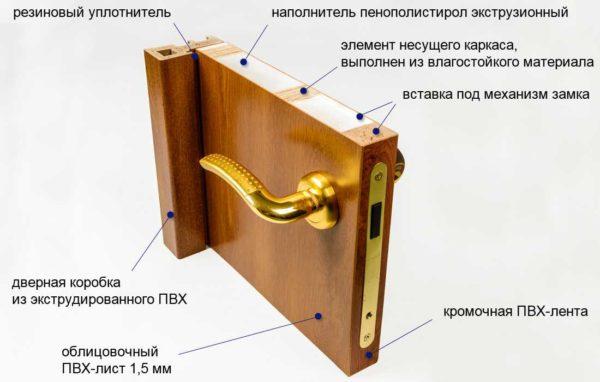
По същата технология се изработват и PVC вратите за баня. С единствената разлика, че рамката е облицована с екструдирано PVC. Плътността и здравината на PVC са многократно по-високи, така че и издръжливостта е по-висока. По-добри и експлоатационни качества: Винилът не се страхува от вода под никаква форма, така че за бани и тоалетни е чудесен вариант.
Комбиниран
Когато се говори за комбинирани врати, най-често се има предвид, че те имат вложки от друг материал. И най-често това са стъклени вложки. Размерът на стъклото може да варира значително. То може да бъде тясна ивица по един от ръбовете или голямо парче за половината врата. Използва се и непрозрачно, закалено или ламинирано стъкло. Ако стъклото в модела, който харесвате, е твърде прозрачно, можете да залепите върху него самозалепващ се витраж или полупрозрачно фолио.
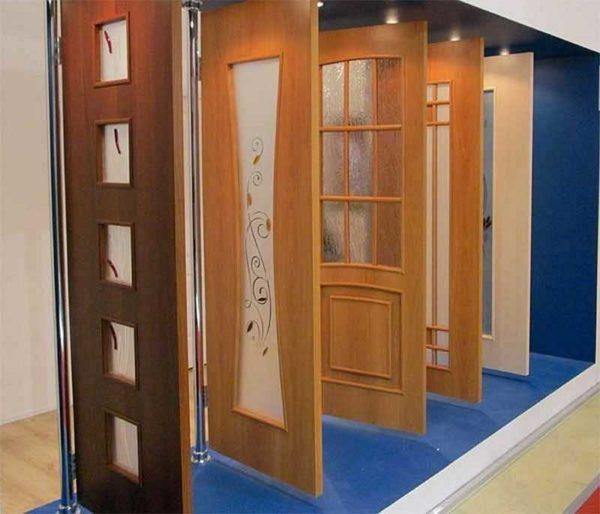
Стъклените вложки се изработват в дървени, металопластични и фурнировани врати. Рядко - в MDF и почти никога - в пластмаса. Но най-интересните модели се намират в тази категория - повече място за фантазия.
Системи за отваряне
В допълнение към различните материали, вратите за баня и тоалетна могат да имат различни видове отваряне. Познатият за нас вариант - люлеещи се врати. Всички те са добри, с изключение на това, че в отворено състояние покриват солидно пространство.
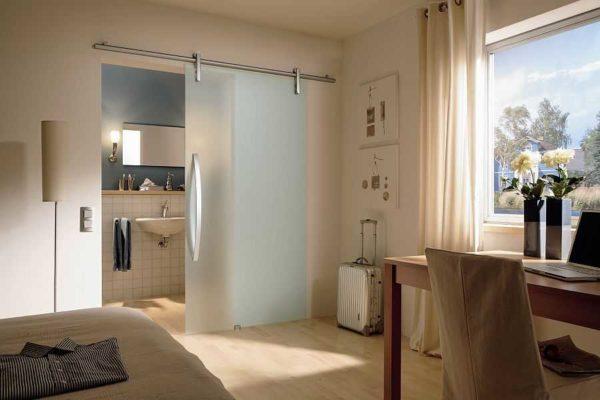
Ролетните врати стават все по-популярни напоследък. Това се случва, когато към горната част на вратата е прикрепен прът, към крилото на вратата са прикрепени ролки и вратата се търкаля по този прът. Според начина на монтиране на водача плъзгащите се врати биват отворени и скрити. Отворени - когато прътът е прикрепен към стената от едната страна, а крилото се движи по стената. При скритата система в стената се прави ниша, в която се движи крилото на вратата.
Вторият вариант в отворена форма не заема почти никакво място, но при монтажа изисква сериозна намеса в структурата на стената, което не винаги е възможно. Малко вероятно е да е възможно да се издълбае ниша с необходимия размер в бетонна или дори тухлена преграда. След това, за да се скрие платното, се изгражда фалшива стена от гипсокартон.
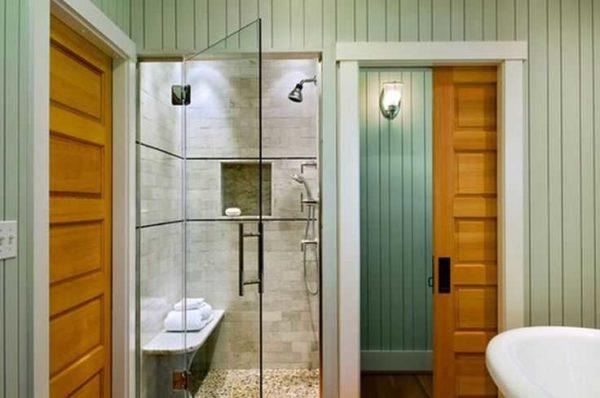
Недостатъкът на плъзгащите се врати е по-сложният монтаж, а отворените системи имат ниска степен на звукоизолация (крилото просто виси по протежение на вратата, оставяйки плътни пролуки). Скритите системи са по-добри в това отношение - има рамка на вратата, с жлеб, в който влиза крилото на вратата, и уплътнение в този жлеб. Такива системи имат добра звукоизолация, но са скъпи.
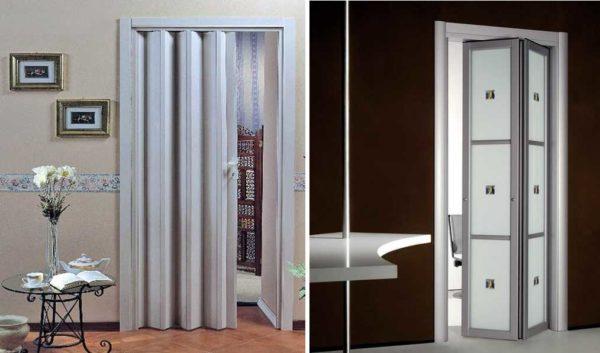
Друг вид врати - сгъваеми. Съществуват два вида - "книга" и "хармоника". Вратите-книги имат крило на вратата, състоящо се от няколко части. Тези части са подвижно свързани, като при отваряне се сгъват, наподобявайки книга. Вратите-акордеон имат подобна структура, но се сгъват по различен начин: спрямо оста, минаваща по средата. Вратите-книжарница често са стъклени, могат да бъдат изработени от МДФ или пластмаса, вратите хармоника по-често са изработени от пластмаса и струват малко.

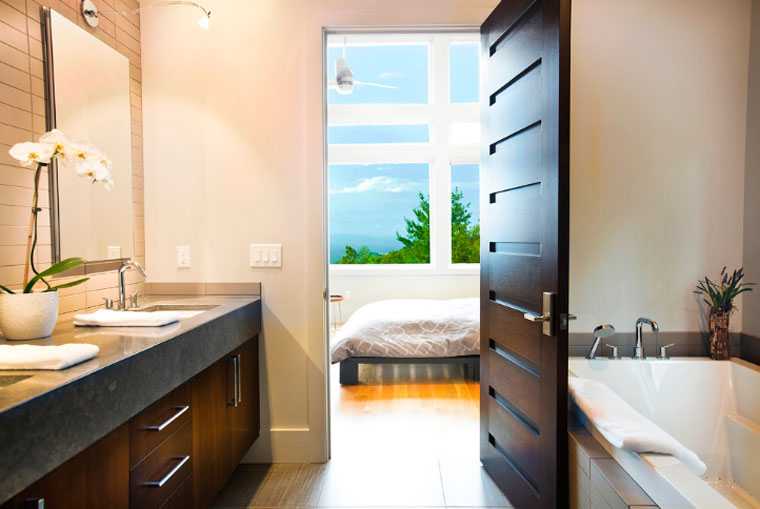

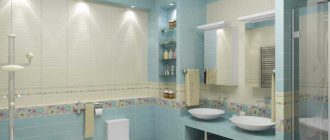
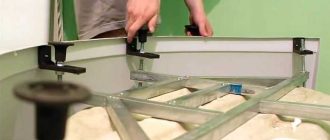
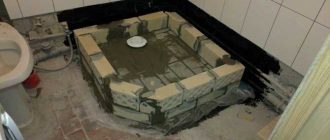
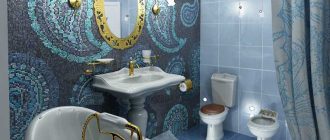
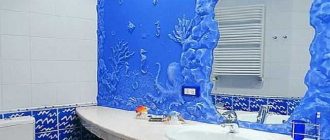
Здравейте, наскоро монтирах врата за мокрото си помещение и това е огромна разлика! Вече не се разлива вода навсякъде и изглежда елегантно. Повярвайте ми, инвестицията в правилната врата може да ви спести куп неприятности и да поддържа реда. Напълно си заслужава!
Hey! Totally get you! I did something similar for my bathroom. Installed a glass shower door, and it was a game changer! No more soggy mats, and it really upgrades the look. Worth every penny to keep things neat and stylish! Cheers to those little wins! 🛁✨
Наскоро преустроих мокрото си помещение и трябва да кажа, че добрата врата е от голямо значение! Избрах стилна стъклена, която поддържа свежо и светло излъчване. Напълно промени играта - никакви мокри подове повече! Наистина оценявам начина, по който свързва всичко заедно.